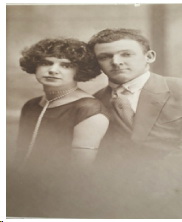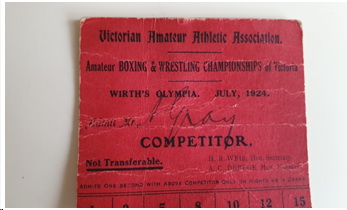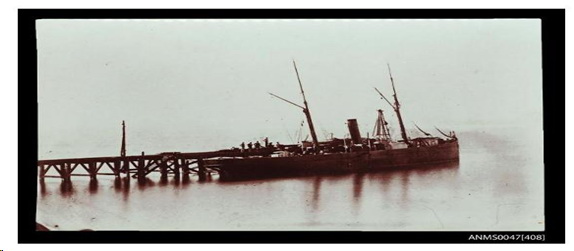
Arthur Charles Mauldon Gray (grandfather to Linda O’Brien) was born Australia Day 1905. On the occasion of his birth, his Aunt Jane, purchased a lottery ticket for him, the ticket resulted in a one thousand pound win. Frequently at family gatherings he would remind those assembled that he was the recipient of a winning ticket but he never saw a B penny of it. (The picture at left is of Arthur with his wife Annie)
 However, we do know, his mother purchased two properties in South Melbourne and opened a laundry business. Arthur was one of eleven children and was eighteen when his mother died. At the time of his marriage in 1926 his occupation is listed as Brass Finisher. He went on to become a Hydraulics Engineer. During the depression he was put onto a 3 day working week to make ends meet. He took on occasional work at the wharf and some paid boxing matches (as he was already an interested amateur boxer). I diverge the purpose of this article is his name Arthur Charles Mauldon, named after his uncle on his mother’s side, who was 2nd engineer on the ill-fated SS Glenelg....below is the story of the SS Glenelg, taken from the Heritage Victoria Web Page
However, we do know, his mother purchased two properties in South Melbourne and opened a laundry business. Arthur was one of eleven children and was eighteen when his mother died. At the time of his marriage in 1926 his occupation is listed as Brass Finisher. He went on to become a Hydraulics Engineer. During the depression he was put onto a 3 day working week to make ends meet. He took on occasional work at the wharf and some paid boxing matches (as he was already an interested amateur boxer). I diverge the purpose of this article is his name Arthur Charles Mauldon, named after his uncle on his mother’s side, who was 2nd engineer on the ill-fated SS Glenelg....below is the story of the SS Glenelg, taken from the Heritage Victoria Web PageStatement of Significance
SS  Glenelg is historically significant as one of the worst maritime disasters in Victorian history, with the deaths of at least 38 people and only three survivors. The wreck has the potential for archaeological significance with some of the hull preserved under the sand. These remains may provide unknown technical detail of iron shipbuilding, details of the refit the vessel underwent in 1898 and information pertaining to life on board a typical cargo/passenger vessel at the turn of the century. SS Glenelg is representative of the fleet of small iron steamers on the small country trading routes around Australia
Glenelg is historically significant as one of the worst maritime disasters in Victorian history, with the deaths of at least 38 people and only three survivors. The wreck has the potential for archaeological significance with some of the hull preserved under the sand. These remains may provide unknown technical detail of iron shipbuilding, details of the refit the vessel underwent in 1898 and information pertaining to life on board a typical cargo/passenger vessel at the turn of the century. SS Glenelg is representative of the fleet of small iron steamers on the small country trading routes around Australia
 Glenelg is historically significant as one of the worst maritime disasters in Victorian history, with the deaths of at least 38 people and only three survivors. The wreck has the potential for archaeological significance with some of the hull preserved under the sand. These remains may provide unknown technical detail of iron shipbuilding, details of the refit the vessel underwent in 1898 and information pertaining to life on board a typical cargo/passenger vessel at the turn of the century. SS Glenelg is representative of the fleet of small iron steamers on the small country trading routes around Australia
Glenelg is historically significant as one of the worst maritime disasters in Victorian history, with the deaths of at least 38 people and only three survivors. The wreck has the potential for archaeological significance with some of the hull preserved under the sand. These remains may provide unknown technical detail of iron shipbuilding, details of the refit the vessel underwent in 1898 and information pertaining to life on board a typical cargo/passenger vessel at the turn of the century. SS Glenelg is representative of the fleet of small iron steamers on the small country trading routes around AustraliaDetails...SS Glenelg was one of the worst maritime disasters in Victoria where at least 38 people lost their lives and only three survived. The Scottish-built Glenelg was a small iron steamer that had carried cargo and passengers on various routes around Australia since 1875. The ship had been a Sydney Harbour ferry and had also transported many copper miners between Melbourne and Strachan during the heady days of the Tasmanian copper mining ventures of the 1880s. Glenelg was sold to JB Ellerker in 1898, the passenger and cargo areas were fitted out, and the ship was put on the Lakes Entrance to Melbourne run. On the night of 25 March 1900, SS Glenelg had just picked up its final load at Cunninghame (Lakes Enrance) and headed for Melbourne. A heavy south west gale and thunderstorm hit the vessel not long after departure. Despite attempts by the crew to bail out the ship, Captain English was forced to abandon the vessel early the next morning. Three crew members launched the first lifeboat, but other passengers and crew had difficulty as this lifeboat was on the rough side of the wreck. The second life boat was eventually launched over the other side and the majority of passengers and crew were in it. The captain, his first mate and the chief engineer all went down with the ship. The crew in the first lifeboat tried to reach and help the second boat but were separated in the heavy seas and the second boat was never seen again. The three crew men drifted for two days before eventually coming ashore at Marlo. Over the next few weeks, bodies were washed up along 90 mile beach some unrecognisable and some were never accounted for. Despite extensive sea searches, the wreck of the Glenelg disappeared for over 100 years. The drawn out marine inquiry held after the wrecking could not find enough evidence to lay blame on anything in particular for the wreck, despite accusations during the trial of poor maintenance and leaky hull plating. The final resting place of the SS Glenelg was finally located by Southern Ocean Exploration (SOE) on 29 June 2009. After two years of historical research, the group managed to find the wreck on only the second attempt over the site. Heritage Victoria provided a permit for a ceramic plate to be raised to assist in positively identifying the wreck. This plate was stamped with the logo of the Tasmanian Steam Navigation Company (TSNC). While the TSNC had never owned the Glenelg, the Union Steam Ship Company had and this company had purchased the TSNC in 1891. Crockery from the TSNC had more than likely been distributed across the entire fleet. Unfortunately, in February 2011, Southern Ocean Exploration reported more than 150 items, including cutlery, crockery and glass bottles had been illegally removed from the wreck site. A 500m protected zone was declared around the wreck of the SS Glenelg by the Commonwealth government on 24 February 2011. This protected zone now cannot be entered without a permit. Heritage Victoria actively monitors the site for any further signs of disturbance.
Passengers ...Mr. & Mrs Hyatt, of Ballarat, Mr. Barker & Miss Barker, Miss Bean, Mr. Hand, Mr. G.P. Scott, Mr. H.B. Holland, Miss H. M. Anderson, Mr. R. Weir, Mrs. (Miss) Moran, Mr. & Mrs. Cowell, Mr. John Holoway Griffiths (ass. printer at the Age), Mrs. Martha Amy Griffiths Albert (8) & Ethel Griffiths (12), Mr. R. Scott, Mr. W.G. Scott, Mr. R. Palmer, Mrs. Lynch & child, Mr. J. Lillicrap, Mr. Stephens, Miss Lily Stephens.
Crew....Master T English - Chief Officer - John Burke Chief Engineer - D. Fyffe 2nd Engineer - Arthur Moulden Fireman - T. Hatfield Fireman - Con. Williams Fireman - M. Williams Steward - W. Tomlinson Stewardess - Mrs. Boyd Boatswain - H. Lapthorne Able seaman - Peter Benson Able seaman - Charles Evans Seaman - George Wright *Seaman - Alexander Lamb *Cook - Valentine Bundy *Under-steward - Ernest Thorne **Alfred Richardson ** James (Albert) Waters *survivors **possibly onboard but unconfirmed